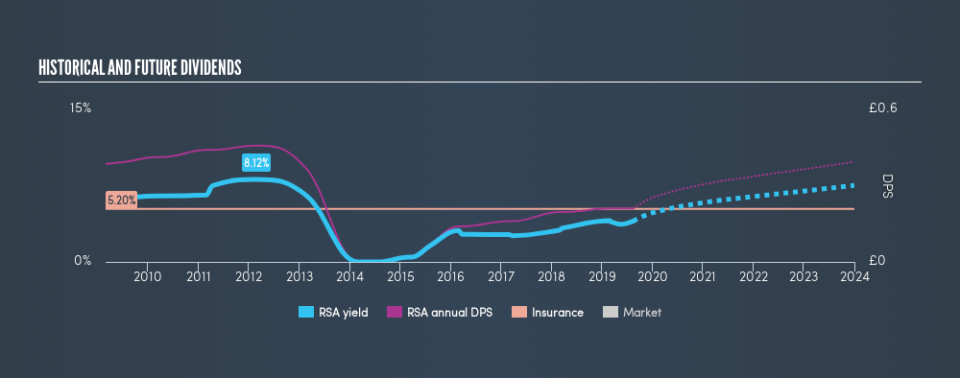Here's What You Should Know About RSA Insurance Group plc's (LON:RSA) 4.0% Dividend Yield

Today we'll take a closer look at RSA Insurance Group plc (LON:RSA) from a dividend investor's perspective. Owning a strong business and reinvesting the dividends is widely seen as an attractive way of growing your wealth. Yet sometimes, investors buy a popular dividend stock because of its yield, and then lose money if the company's dividend doesn't live up to expectations.
In this case, RSA Insurance Group likely looks attractive to investors, given its 4.0% dividend yield and a payment history of over ten years. It would not be a surprise to discover that many investors buy it for the dividends. Before you buy any stock for its dividend however, you should always remember Warren Buffett's two rules: 1) Don't lose money, and 2) Remember rule #1. We'll run through some checks below to help with this.
Click the interactive chart for our full dividend analysis
Payout ratios
Dividends are usually paid out of company earnings. If a company is paying more than it earns, then the dividend might become unsustainable - hardly an ideal situation. As a result, we should always investigate whether a company can afford its dividend, measured as a percentage of a company's net income after tax. In the last year, RSA Insurance Group paid out 84% of its profit as dividends. It's paying out most of its earnings, which limits the amount that can be reinvested in the business. This may indicate limited need for further capital within the business, or highlight a commitment to paying a dividend.
Remember, you can always get a snapshot of RSA Insurance Group's latest financial position, by checking our visualisation of its financial health.
Dividend Volatility
From the perspective of an income investor who wants to earn dividends for many years, there is not much point buying a stock if its dividend is regularly cut or is not reliable. RSA Insurance Group has been paying dividends for a long time, but for the purpose of this analysis, we only examine the past 10 years of payments. This dividend has been unstable, which we define as having fallen by at least 20% one or more times over this time. During the past ten-year period, the first annual payment was UK£0.39 in 2009, compared to UK£0.21 last year. The dividend has shrunk at around 5.9% a year during that period. RSA Insurance Group's dividend has been cut sharply at least once, so it hasn't fallen by 5.9% every year, but this is a decent approximation of the long term change.
We struggle to make a case for buying RSA Insurance Group for its dividend, given that payments have shrunk over the past ten years.
Dividend Growth Potential
With a relatively unstable dividend, and a poor history of shrinking dividends, it's even more important to see if EPS are growing. Strong earnings per share (EPS) growth might encourage our interest in the company despite fluctuating dividends, which is why it's great to see RSA Insurance Group has grown its earnings per share at 67% per annum over the past five years. RSA Insurance Group earnings have been growing very quickly recently, but given that it is paying out more than half of its earnings, we wonder if it will have enough capital to fund further growth in the future.
Conclusion
When we look at a dividend stock, we need to form a judgement on whether the dividend will grow, if the company is able to maintain it in a wide range of economic circumstances, and if the dividend payout is sustainable. First, we think RSA Insurance Group has an acceptable payout ratio. Unfortunately, the company has not been able to generate earnings per share growth, and cut its dividend at least once in the past. RSA Insurance Group might not be a bad business, but it doesn't show all of the characteristics we look for in a dividend stock.
Earnings growth generally bodes well for the future value of company dividend payments. See if the 10 RSA Insurance Group analysts we track are forecasting continued growth with our free report on analyst estimates for the company.
We have also put together a list of global stocks with a market capitalisation above $1bn and yielding more 3%.
We aim to bring you long-term focused research analysis driven by fundamental data. Note that our analysis may not factor in the latest price-sensitive company announcements or qualitative material.
If you spot an error that warrants correction, please contact the editor at editorial-team@simplywallst.com. This article by Simply Wall St is general in nature. It does not constitute a recommendation to buy or sell any stock, and does not take account of your objectives, or your financial situation. Simply Wall St has no position in the stocks mentioned. Thank you for reading.

 Yahoo Finance
Yahoo Finance 
